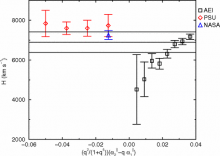
Abstract
We test the accuracy of our recently proposed empirical formula to model the recoil velocity imparted to the merger remnant of spinning, unequal-mass black-hole binaries. We study three families of black-hole binary configurations, all with mass ratio q=3/8 (to maximize the unequal-mass contribution to the kick) and spins aligned (or counter aligned) with the orbital angular momentum, two with spin configurations chosen to minimize the spin-induced tangential and radial accelerations of the trajectories respectively, and a third family where the trajectories are significantly altered by spin-orbit coupling. We find good agreement between the measured and predicted recoil velocities for the first two families, and reasonable agreement for the third. We also re-examine our original generic binary configuration that led to the discovery of extremely large spin-driven recoil velocities and inspired our empirical formula, and find reasonable agreement between the predicted and measured recoil speeds.